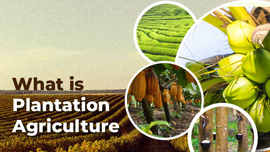Complete Guide to Spinach Farming in India: Varieties, Importance & Best Practices

While all green, leafy vegetables pack a nutritious punch, spinach truly stands out as a top contender in the nutrition. It can be cultivated throughout the year based on the variety, soil, and climate of the region. Spinach farming holds a good business opportunity for Indian farmers. Let us delve into the world of spinach cultivation along with best practices to grow spinach successfully.
Table of Contents
- Introduction to Spinach Farming in India
- Nutritional Profile and Importance of Spinach
- What are the Different Varieties of Spinach?
- How to Grow Spinach Successfully in India?
Introduction to Spinach Farming in India
Spinach beet or palak (Beta vulgaris L. var. bengalensis) is known to have originated from the Mediterranean region. However, there is no exact information about its origin. It is likely that this vegetable has originated from Beta vulgaris subsp. Maritima (wild sea beet), which is native to the Indo Chinese region. Palak is a leafy green vegetable belonging to the Chenopodiaceae family. This vegetable can grow up to 120 cm in height, and its flowers are pollinated by insects or wind. This vegetable has tender, dark green leaves with a bit of glossy texture. It is widely used in a variety of culinary preparations.
Spinach beet is mainly grown in tropical and subtropical regions. In India, it is widely cultivated in states like Gujarat, Bihar, Delhi, Uttar Pradesh, Punjab, Rajasthan, Maharashtra, Madhya Pradesh and West Bengal. Palak is observed to be less popular in South India.
Nutritional Profile and Importance of Spinach
Palak is rich in minerals and has a high protective food value. This is why it has earned the reputation of being Mines of Minerals. This vegetable is an affordable source of vitamins (A, K, E, D, C), calcium, iron, thiamine, folic acid, nicotinic acid, riboflavin, and pyridoxine. Other key minerals include potassium, iron, magnesium, manganese, zinc, and copper, which help regulate blood pressure. Spinach offers antioxidants like flavones, isothiocyanates, and carotene in abundance.
Following is the nutritional profile per 100 g of edible portion:
|
Contents |
Amount |
|
Energy |
46 Kcal |
|
Vitamin A |
5862 IU |
|
Moisture |
86.4% |
|
Carbohydrate |
6.5 g |
|
Protein |
3.4 g |
|
Fat |
0.8 g |
|
Niacin |
380 mg |
|
Calcium |
70 mg |
|
Phosphorus |
30 mg |
|
Ascorbic acid |
3.3 mg |
|
Riboflavin |
0.56 mg |
|
Thiamin |
0.26 mg |
Due to such a nutritional profile, palak offers a wide range of health benefits, including cataract protection, muscle and bone mineralization, nervous system benefits, anti-ulcerative capabilities, and protection against macular degeneration. It is also usually used in the form of a medicinal herb.
What are the Different Varieties of Spinach?
Based on the colour of the midrib and leaf veins, palak is categorized into:
- Green midrib and leaf veins
- Reddish midrib and leaf veins
|
Cultivar |
Characteristics |
|
Pusa Bharti |
|
|
Pusa Jyoti |
|
|
All green |
|
|
Pusa palak |
|
|
Pusa Harit |
|
|
Jobner Green |
|
|
Ooty 1 |
|
|
Punjab Green |
|
How to Grow Spinach Successfully in India?
Spinach farming can be easily pursued on a large scale with suitable knowledge and following these steps:
Soil & Climate
Spinach beet is mainly a crop of the winter season. Nevertheless, it can be cultivated throughout the year, and its frost tolerance is better than many other vegetables. Palak also has tolerance to warm weather; however, premature bolting can be caused due to high temperatures with no economic yield.
Fertile soil with adequate drainage is ideal for spinach cultivation. However, sandy loam soil is considered the most suitable for growing spinach. Even though it can endure slightly alkaline soil, better quality and high yields are obtained in neutral soil with a 7-pH level.
Land Preparation & Spacing
Seeds are kept in water for one full night to improve germination. Generally, the broadcasting technique is used to sow seeds. However, line sowing is preferred as it simplifies weeding, hoeing, and harvesting.
A spacing of 30 cm x 5 cm is ideal for spinach farming. Germination begins within ten days of sowing. There is a need for suitable moisture in palak seeds for proper germination. Pre-sowing irrigation is recommended for improved germination as well as moisture absorption of seeds.
Seeding Rate & Sowing Time
A single palak fruit has 2 to 3 seeds. Seed propagation is used to cultivate spinach. Also, the seed rate depends on the crop seasons. In the case of summer crops, 20 to 25 kg of seeds are required for one hectare. On the other hand, it is 10 to 15 kg for winter crops.
Palak is planted in September-November in plains. For hilly areas, the ideal sowing time is Mar-May and Aug-Sep.
Manures & Fertilizers
Being a leafy vegetable, palak needs high amounts of nitrogen for crop growth. 15 to 20 tonnes of Farmyard Manure (FYM) is the standard dosage. Also, it is recommended to apply NPK in the ratio of 90:30:30 kg/ha. When performing the last ploughing, a full dosage of FYM should be incorporated into the soil. Half N and full P & K can be applied as the basal dose. The remaining dosage of N needs to be applied after every cutting in 3 split doses. It is followed by a light irrigation. As a growth regulator, gibberellic acid (GA) is used with 1 % urea to increase spinach yield.
Irrigation
After sowing, immediate light irrigation is required. Frequent irrigation is needed at an interval of 4-6 days for summer crops. For autumn and winter crops, it is important to irrigate at an interval of 10-12 days. Much irrigation is not required during the rainy season; it is mostly done during long dry spells.
Intercultural Operations
- Weeding & Hoeing: Regular weeding and shallow hoeing are important for improved growth at the initial growth stage. 2 to 3 hoeing with hand weeding helps control weeds.
- Thinning: It is performed to offer adequate space and resources to crops, ensuring healthy and large uniform plants.
Pest & Disease Management
Young spinach seedlings are at risk of attack from Pythium sp., which causes damping off after germination. It can be handled by avoiding excess moisture and seed treatment with thiram or captan at 3g per kg of seed. The leaf and leaf petioles of spinach are attacked by Cercospora beticola, which causes the Cercospora leaf spot. This soil-borne disease results in wrinkles, and the leaves eventually dry and fall. To manage this disease, seeds need to be treated with carbendazim at 3g/kg of seed and 2-3 sprays of copper oxychloride at 0.3% (3 g/litre of water).
Aphids attack the sap from fruits, flowers, and leaves. It can be controlled by applying metasystox and phosphamidon at 0.05% at an interval of 10 to 15 days. Laphygma exiqua are leaf-eating caterpillars that cause key damage in the early growth stages. The crop can be protected by spraying chloropyriphos (0.1%), phosphamidon (0.1%), and methyldemeton (0.1%).
Harvesting
Harvesting is usually done after 3 to 4 days of sowing. It also depends on the season and variety. Cuttings are done at an interval of 20–25 days between each round. Generally, 3 to 4 cuttings are observed in harvesting palak. Winter crops offer more cuttings than summer crop types. A sickle or sharp knife is used to cut the leaves just above the roots. If there is dew on the leaves in the early morning, it is not recommended to harvest spinach.
The average yield of green leaves is 80-100 q/ha (Spring-summer) and 100-150 q/ha (winter). After cleaning, trimming, grading and bunching, leaves are ready to be sold in the market. It is important to remove yellow or sick leaves before marketing.
Spinach is highly demanded in India because of its nutritional value. This is why it offers major economic benefits to farmers. This valuable food source is easy to harvest multiple times in a season. Continuous crop improvement aims to develop superior Palak varieties while fulfilling the evolving demands of cultivators and consumers. Follow this guide to cultivate spinach successfully in India and set up a profitable venture.


Related Blogs












